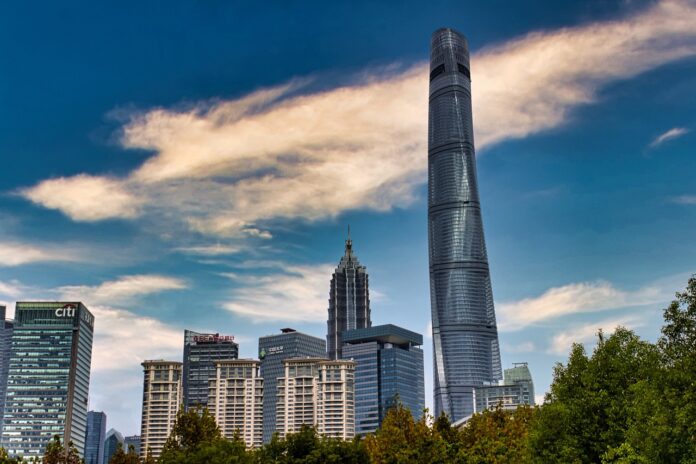The 632-meter Shanghai Tower is completely immobile. In essence, it is the most stable skyscraper in the world—neither wind nor other weather phenomena can disturb its balance. However, this is an illusion: of course, there are vibrations, but thanks to an ultra-modern damping system, no one can feel the “movement” of the building.
Imagine the Following Scenario
Imagine holding a one-meter-long cane vertically. If you move your hand, you will need to exert effort to return it to a stable position. But if you attach a small weight on a spring to the top of the cane, its inertia will compensate for part of the kinetic energy, turning a sharp movement into a smooth oscillation.
Can you picture it? Now, scale this construction up several hundred times—and you have the Shanghai Tower. But how are tall buildings like this built, and why don’t skyscrapers fall?
How the Chinese Build Skyscrapers
The system used in its construction is called a damper, which helps reduce the amplitude of wind-induced vibrations and slows down the “top” of the building during these oscillations. Similar dampers—spring-loaded weights—were once used in Formula 1 cars to reduce vertical vibrations of the car’s front end. Now, they are used in skyscraper construction.
A standard damper used in construction consists of a “set” of pendulums—flexibly linked steel plates. When workers build a skyscraper, it tilts to one side, and the inertia of the plates acts as a counterweight, pushing the building in the opposite direction. However, such a damper was not sufficient for the Shanghai Tower.
How Skyscrapers Are Built at the Final Stage
On the upper floors of the 632-meter skyscraper, vibrations can be so noticeable that they can cause “air sickness” among employees or residents, meaning people could get motion sickness! Not to mention the subconscious fear associated with the building collapsing.
Therefore, the Chinese, who build the skyscraper, applied an original technology. On the upper floors, they installed a carefully calculated mass—the heaviest weight ever used in architectural dampers—and connected it to a powerful electromagnet, creating the first inductive damper in construction history. Without this mechanism, we would not see how skyscrapers are built—they would simply collapse even before construction begins.
The “heart” of the device is a 100 m² copper plate, on which 125 powerful magnets are installed, and the entire structure is located under a suspended classic-type damper. When the building shifts, the 1000-ton steel weight moves over the magnets, causing an electric current to appear in the plate. This, in turn, creates a magnetic field that resists the movement of the damper, increasing the damping effect.
No active control of the system is required, as all the work of the damper is determined by Lenz’s law: “The induced current always has a direction such that it opposes the cause that produced it.” This is how the use of a damper helps improve the process of how skyscrapers are built.
Elegant Engineering and Visible Outcomes
As a result, there is both an elegant engineering solution and a visible outcome. Architects claim that 99.99% of visitors to the upper floors feel no vibrations, even in summer when typhoons in Shanghai are particularly active. It’s no secret that China builds skyscrapers very well. But it’s not just a matter of necessity, but also of skill, as you may have noticed, skyscrapers are built by very experienced people with unconventional thinking.
Why Don’t Skyscrapers Fall?
We’ve already understood how skyscrapers are built, but the process of their operation is equally important. Why don’t these tall buildings fall? There are several reasons:
- Skyscrapers are built in such a way that their weight is distributed in a specific manner. Even if several thousand tons of its mass were on one side, it would immediately collapse downward, not sideways.
- The foundation on which the skyscraper is built simply prevents it from falling. Due to the large weight, the building is more likely to collapse downward rather than fall over like the Leaning Tower of Pisa.
- The design of the future building initially includes a greater load than it will be subjected to during operation.
